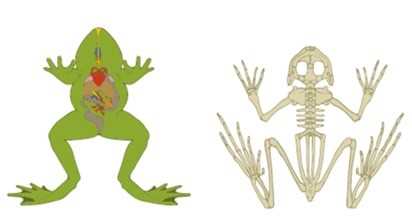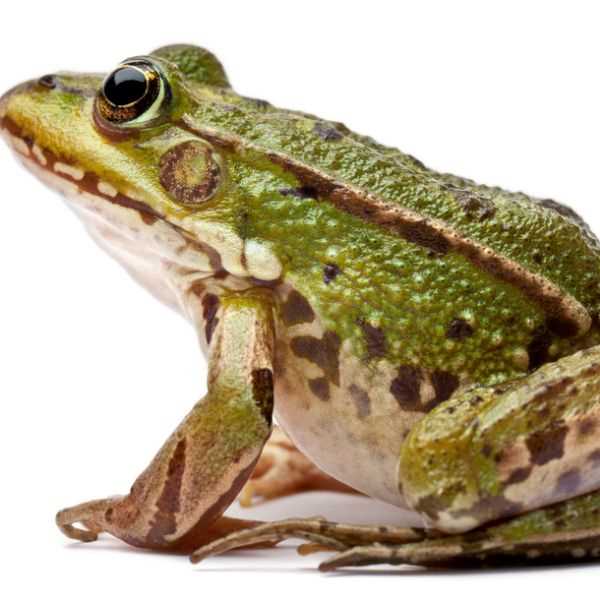
What are frogs?
Unlike reptiles, frogs do not have scales or claws. Instead, they have smooth skin that is covered in a layer of mucus, which helps keep them moist and allows them to breathe through their skin. This unique adaptation is what makes frogs more closely related to fish than to reptiles.
Frogs are ectothermic, which means their body temperature is determined by the temperature of their environment. They are also carnivorous, feeding on insects and other small creatures. They have a long, sticky tongue that they use to catch their prey, which they then swallow whole.
Classification of frogs
Frogs are a diverse group of amphibians that belong to the order Anura. They are ectothermic vertebrates, meaning their body temperature is regulated by their environment. There are more than 7,000 known species of frogs, making them one of the most abundant and diverse groups of vertebrates on Earth.
Frogs can be found in a wide range of habitats, including forests, swamps, ponds, lakes, and even deserts. They have adapted to live in both terrestrial and aquatic environments, with some species able to live in both habitats throughout their life cycle.
| Family | Common Name | Examples |
|---|---|---|
| Ranidae | True frogs | American bullfrog, green frog |
| Hylidae | Tree frogs | Red-eyed tree frog, spring peeper |
| Bufonidae | True toads | American toad, cane toad |
Each family of frogs has its own unique characteristics and adaptations that allow them to thrive in their specific habitats. For example, tree frogs have specialized toe pads that allow them to climb and adhere to vertical surfaces, while true frogs have webbed feet that make them excellent swimmers.
Characteristics of Frogs
Frogs are amphibians, belonging to the order Anura. They have a unique set of characteristics that distinguish them from other animals.
One of the most distinctive features of frogs is their specialized skin, which is smooth, moist, and glandular. This skin allows them to breathe through it, facilitating gas exchange. It also helps them absorb water and prevent dehydration. Some species of frogs also have the ability to change the color of their skin for camouflage or communication purposes.
Most frogs have a well-developed sense of hearing and vision. They have large, round eyes positioned on the sides of their heads, allowing them to see in almost all directions. The eyes also play a crucial role in hunting, as frogs rely on their excellent eyesight to locate prey and pounce on it with lightning speed.
One fascinating characteristic of frogs is their ability to produce a wide range of sounds. Male frogs use vocalizations to attract females and establish territories. Different species of frogs have distinct calls, which can vary in pitch, duration, and volume.
Frogs are ectothermic, meaning that their body temperature fluctuates with the surrounding environment. They can adjust their body temperature by moving to warmer or cooler areas, depending on the weather conditions.
Overall, these unique characteristics make frogs fascinating creatures that play an important role in ecosystems worldwide.
Are frogs vertebrates?
Frogs are indeed vertebrates. They belong to the class Amphibia, which includes animals that have a backbone. Vertebrates are animals with an internal skeleton made up of bones or cartilage, and frogs possess this characteristic.
As vertebrates, frogs share certain common features with other members of their class, including a well-developed spinal column, a skull that protects the brain, and a segmented body. They also have a well-defined head and limbs, which allow them to move and navigate their environment.
Class Amphibia

Frogs, along with other amphibians such as salamanders and caecilians, belong to the class Amphibia. This class is characterized by their ability to live both on land and in water. While frogs spend most of their time in water, they are capable of moving on land and can breathe through their skin.
Importance of Vertebrates
Being vertebrates, frogs have an important role in ecosystems. They are both predator and prey, contributing to the balance of food chains. Frogs also serve as indicators of environmental health and ecosystem diversity.
Frog Anatomy
Frogs, like other amphibians, have a unique anatomy that allows them to adapt to both aquatic and terrestrial environments. Their body is divided into several distinct parts.
The head of a frog is equipped with a pair of large, protruding eyes, which provide them with excellent vision. They also have a set of eardrums, called tympanic membranes, located behind their eyes. These eardrums allow them to detect sound waves and communicate with other frogs.
In addition to their eyes and ears, frogs have a long, sticky tongue that they use to catch prey. Their tongue can extend and retract rapidly, allowing them to catch insects and other small animals in a matter of seconds.
Another notable feature of a frog’s anatomy is their limbs. Frogs have powerful hind legs that are adapted for jumping and swimming. These hind legs are equipped with webbed feet that assist in swimming and provide better traction on land.
Unlike most animals, frogs do not have a traditional neck. Their head is connected directly to their body, allowing for quick movements and flexibility.
Frogs also have a unique respiratory system. They breathe through their skin, which is thin and permeable. This allows them to take in oxygen from the air, as well as absorb water through their skin.
The internal organs of a frog are similar to those of other vertebrates. They have a heart, lungs, liver, kidneys, and a digestive system. The digestive system of a frog includes a stomach, small intestine, and large intestine, which help break down and absorb nutrients from their food.
Reproduction of Frogs
Frogs have a unique and fascinating reproductive process. They undergo a process called “external fertilization,” which means that the female lays her eggs, and the male fertilizes them externally. This process takes place in water, as frogs are amphibians and rely on water for reproduction.
Once the female is attracted to a calling male, she approaches him. The male then grasps the female in a position called “amplexus” by wrapping his front legs around her body. This physical contact stimulates the female to release her eggs, while the male simultaneously releases sperm to fertilize the eggs.
Once the eggs are laid, the embryonic development begins. The eggs undergo a process of cell division and growth, eventually hatching into tadpoles. Tadpoles are aquatic larvae that have gills for breathing and a tail for swimming. They feed on algae and other small plant material found in the water.
From this point, the froglets continue to grow and mature into adult frogs, completing their life cycle. The time it takes for a frog to complete its metamorphosis varies between species but typically ranges from a few months to a couple of years.
The reproductive process of frogs is not only fascinating but also essential for their survival as a species. The distinct calls, behaviors, and reproductive strategies of different frog species contribute to the biodiversity and ecological balance of their habitats.
Do frogs have a backbone?
The backbone of a frog is made up of individual bones called vertebrae, which are connected by flexible joints. These vertebrae allow for movement and flexibility, enabling frogs to jump, swim, and perform various other actions. The vertebral column extends from the base of the skull to the tip of the tail, providing structural support for the entire body.
Within the vertebrae of frogs, the spinal cord runs through a central canal, which is surrounded and protected by bone. This spinal cord is a vital part of the nervous system and is responsible for transmitting signals between the brain and the rest of the body. It plays a crucial role in coordinating movements and controlling bodily functions.
In addition to the backbone, frogs also possess other skeletal features that support their body structure. These include a skull to protect the brain, ribs to protect the internal organs, and limbs adapted for jumping or swimming, depending on the species.
Overall, frogs are vertebrates and have a well-developed backbone that allows them to perform their unique behaviors and survive in their various habitats.
Invertebrates
Frogs are not considered invertebrates. In fact, they are classified as vertebrates. While many people may mistakenly think that frogs are invertebrates due to their slimy and soft skin, this is not the case. Invertebrates are animals that do not possess a backbone or a spinal column, while vertebrates do have a backbone.
As vertebrates, frogs belong to the class Amphibia. They are cold-blooded animals that have a distinct head, a backbone, and limbs. Unlike invertebrates, frogs have a well-developed skeletal system that includes a spinal cord and ribcage.
In addition to their skeletal system, frogs also have other characteristics typical of vertebrates. They have a closed circulatory system with a heart, lungs for respiration, and a nervous system that allows them to react to their environment. These features are crucial for the survival and function of vertebrates like frogs.
While frogs may share some physical similarities with invertebrates, such as a soft and moist skin, they are fundamentally different due to their possession of a backbone. Being vertebrates, frogs occupy a unique position in the animal kingdom, allowing for a diverse range of species and adaptations.
Are frogs considered invertebrates?
No, frogs are not considered invertebrates. In fact, they are vertebrates, belonging to the class Amphibia. Vertebrates are animals that have a backbone or spinal column, which is made up of individual vertebrae. Frogs, along with other amphibians, reptiles, birds, and mammals, are all vertebrates.
Unlike invertebrates, which lack a backbone, frogs have a well-developed skeletal system that includes a spinal column. This backbone provides support and structure to their bodies, allowing them to move and perform various activities.
In addition to having a backbone, frogs also possess other characteristics of vertebrates, such as a closed circulatory system, a well-developed nervous system, and a brain. They also have a complex respiratory system that includes lungs and the ability to breathe through their skin.
While frogs may share some similarities with invertebrates, such as having an exoskeleton or being able to regenerate certain body parts, they are fundamentally different in terms of their anatomical structure. It is their possession of a backbone that sets them apart and classifies them as vertebrates.
Why are frogs not invertebrates?
Frogs belong to the class Amphibia, which is a group of vertebrates that also includes salamanders and caecilians. As amphibians, frogs have a complex life cycle that involves both aquatic and terrestrial stages. They undergo metamorphosis, starting as eggs laid in water, hatching into tadpoles that breathe through gills, and eventually transforming into adults that breathe through lungs.
Frogs have adapted to various habitats, including freshwater, terrestrial, and even arboreal environments. They have specialized skin that allows them to absorb oxygen and release carbon dioxide, enabling them to breathe even when submerged in water. This unique adaptation is one of the reasons why frogs are often associated with wet and moist environments.
Despite their classification as vertebrates, frogs face numerous threats to their survival. Habitat loss, pollution, climate change, and the spread of invasive species are some of the major challenges that frogs and other amphibians must overcome. Conservation efforts are crucial in protecting and preserving the diverse range of frog species found around the world.
Frog Habitats
Frogs are amphibious creatures found in a variety of habitats around the world. They have adapted to live in both terrestrial and aquatic environments, making them incredibly diverse in their choice of homes.
Aquatic Habitats
Many frog species are commonly found in freshwater habitats such as ponds, lakes, rivers, and streams. These habitats provide the necessary moisture for the frogs to breathe through their skin, as well as a rich food source in the form of insects, small fish, and other aquatic organisms.
Some frogs prefer to live in still water bodies like ponds, where they can find shelter among plants and algae. Others are more adapted to faster-moving water, such as streams or rivers, where they can cling to rocks or vegetation to avoid being swept away.
Terrestrial Habitats
While many frogs spend their entire lives in or around water, others have adapted to live in more terrestrial habitats. These frogs can be found in forests, grasslands, deserts, and even urban areas.
Forest-dwelling frogs can be found in the understory, where they take advantage of the abundant leaf litter and moist conditions. They may also seek shelter in fallen logs or under rocks. Grassland frogs, on the other hand, have adapted to living in open, sunny areas and rely on their camouflage to blend in with their surroundings.
Desert frogs are specially adapted to survive in arid conditions, with the ability to bury themselves in the sand during times of drought. Urban frogs are a recent phenomenon, adapting to city life and taking advantage of artificial water sources such as garden ponds or swimming pools.
Specialist Habitats

Overall, frogs are incredibly adaptable creatures that can be found in a wide range of habitats. Their ability to live in both aquatic and terrestrial environments has allowed them to diversify and thrive in many different ecosystems around the world.
Threats to Frogs
Frogs are facing numerous threats that are putting their populations at risk. One of the biggest threats is habitat loss. Deforestation, urbanization, and agricultural expansion are destroying the natural habitats of frogs, leaving them without suitable places to live, breed, and find food.
Another major threat to frogs is pollution. Pesticides, herbicides, and chemical runoff from agriculture and industry contaminate the water bodies where frogs live. This pollution can harm frogs directly or indirectly through the depletion of their food sources and increases their susceptibility to diseases.
Climate change is also impacting frog populations. Rising temperatures and changing weather patterns can alter the delicate balance of ecosystems that frogs rely on. It can disrupt their breeding cycles, limit their access to food, and increase the spread of diseases.
In addition, invasive species pose a significant threat to frogs. Non-native predators and competitors, such as snakes and fish, can prey on frogs or outcompete them for resources, leading to declines in frog populations.
Overexploitation is another threat to frogs, particularly in regions where they are traded as pets or for use in traditional medicine. The capture and trade of frogs for these purposes can deplete populations to unsustainable levels.
To ensure the long-term survival of frogs, conservation efforts are crucial. These efforts involve protecting and restoring their habitats, reducing pollution, implementing measures to mitigate the effects of climate change, controlling the spread of invasive species, and promoting sustainable practices regarding the trade of frogs.
Conservation of Frogs
Conservation of frogs is important because these amphibians play a crucial role in maintaining the balance of ecosystems. As vertebrates, frogs are an integral part of the food chain, both as predators and prey. They help control insect populations, including mosquitoes, which can spread diseases to humans.
However, frogs face numerous threats to their survival. Habitat loss, pollution, climate change, and the spread of invasive species are all contributing factors. Deforestation and urbanization destroy frog habitats, leading to a decline in their populations. Pollutants such as pesticides and chemical fertilizers contaminate their breeding sites and affect their health.
Climate change also poses a significant threat to frogs. Rising temperatures can alter their habitats and disrupt breeding patterns. The increased frequency of extreme weather events, such as droughts and floods, can have devastating effects on frog populations.
Furthermore, the introduction of non-native species can have detrimental effects on native frog populations. Invasive species often outcompete native frogs for resources and can even prey on them.
To conserve frogs, various measures are being taken. Conservation organizations are working to protect and restore frog habitats, create protected areas, and establish breeding programs for endangered species. Public awareness campaigns educate people about the importance of frogs and their conservation. Efforts are also made to regulate the use of pesticides and reduce pollution to minimize their impact on frog populations.

I’m Lena Adams—a product of an unconventional upbringing in the African wilderness. My father, a daring explorer of African wildlife, sparked my fascination with reptiles, a passion that intertwined with the tragic loss of my mother during an expedition, leaving an indelible mark on my life. Driven to understand the creatures that captivated my parents, I embarked on my journey, sharing insights about reptiles, frogs, and lizards on my website. Through my explorations and conservation efforts, I honour my family’s legacy while seeking connections—to the creatures, nature, and the mother whose presence I yearn to understand.
